minutes: ultrasound dicom work group
advertisement
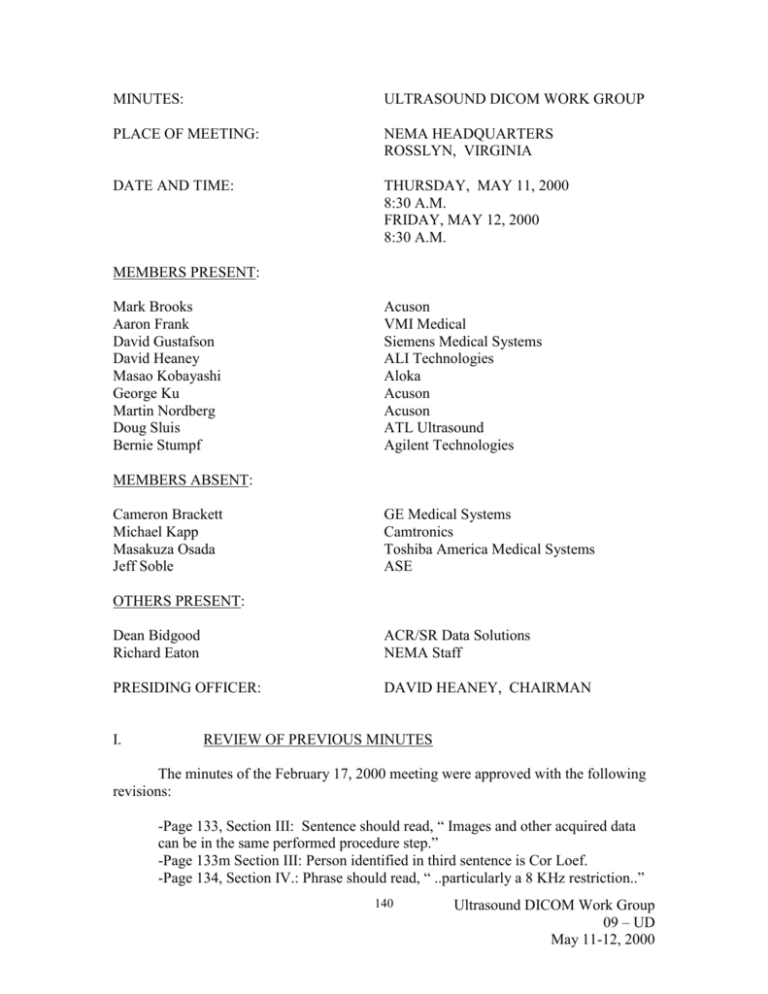
MINUTES: ULTRASOUND DICOM WORK GROUP PLACE OF MEETING: NEMA HEADQUARTERS ROSSLYN, VIRGINIA DATE AND TIME: THURSDAY, MAY 11, 2000 8:30 A.M. FRIDAY, MAY 12, 2000 8:30 A.M. MEMBERS PRESENT: Mark Brooks Aaron Frank David Gustafson David Heaney Masao Kobayashi George Ku Martin Nordberg Doug Sluis Bernie Stumpf Acuson VMI Medical Siemens Medical Systems ALI Technologies Aloka Acuson Acuson ATL Ultrasound Agilent Technologies MEMBERS ABSENT: Cameron Brackett Michael Kapp Masakuza Osada Jeff Soble GE Medical Systems Camtronics Toshiba America Medical Systems ASE OTHERS PRESENT: Dean Bidgood Richard Eaton ACR/SR Data Solutions NEMA Staff PRESIDING OFFICER: DAVID HEANEY, CHAIRMAN I. REVIEW OF PREVIOUS MINUTES The minutes of the February 17, 2000 meeting were approved with the following revisions: -Page 133, Section III: Sentence should read, “ Images and other acquired data can be in the same performed procedure step.” -Page 133m Section III: Person identified in third sentence is Cor Loef. -Page 134, Section IV.: Phrase should read, “ ..particularly a 8 KHz restriction..” 140 Ultrasound DICOM Work Group 09 – UD May 11-12, 2000 II. DISCUSSION OF TEMPLATES AND HL7 ISSUES Dean Bidgood described his activities regarding HL 7 and the development of templates. He urged that WG 12 tie into the work being done by HL 7, and the efforts being headed up by the president of HL 7, Stan Huff. Dean stated that they were close to a template approach which would work with both groups. WG 12, he said, would need to come up with its own approach and identify areas where codes are lacking; to do this, clinical input input would be needed. For SR, there would be a need for: document titles, headings, concept names and code values (which would include templates). He explained the two templates which would related to the machine and the reviewing physician. Dean emphasized that establishment of a process and infrastructure were critical in development of templates and terminology for SR data. Stakeholders included: -Managed Care Organizations -Message SDOs -Terminology Developers SDOs -Multispecialty societies -PACS vendors -Charitable organizations -Pharmaceutical organizations -Government – DOD,VA, NLM -IS/IT companies and IS Vendors It was envisioned that a dynamic web site would be created. People would be able to review terminology and submit terminology for review. The funding needed to compile SR data was outlined. Considerable commitment would be needed. While Dean stated he would be willing to allot considerable time to the effort, greater resources would have to be committed. A white paper would first have to be developed to set forth the process, and approval of both HL 7 and the DICOM Standards Committee would be necessary. Dean Bidgood agreed to organize the effort to develop the white paper. Other DICOM groups would also be apprised of the project. Thereafter an RFP could be issued and bids could then be made. A tentative budget was proposed: $20,000 – Software $80,000 – database research person $ 8,000 – hardware Other resources which would potentially be needed included a dedicated server and database licensee fees. 141 Ultrasound DICOM Work Group 09 – UD May 11-12, 2000 III. REVIEW OF DON EMERSON’S QUESTIONS There was a review of the questions Dr. Don Emerson had submitted on the compilation of ultrasound radiology terminology. Responses were then set forth to Don’s questions. It was agreed that Don’s suggestion to have widespread input in creation of a classification system was sound, and a white paper would be developed to establish a structure and process for receiving input. Whether or not NEMA would host this on the internet would depend on how the requirements for such a system could be met. It was declared that the historical basis for the system were LOINC specifications. The final end use of the LOINC specifications had not yet been defined. Some vendors would use these specifications for presentation of data or display of measurements. LOINC, it was stated handled both qualitative and quantitative items; further development would be needed. The need for a dynamic process was acknowledged. This process would feature a limited number of component values which would be codified themselves. Members felt that an additional white paper should be prepared on coding issues. Issues for consideration included: -How deep does coding have to go ? -What should those codes be ? -How specific should those codes be ? -When should coding be used or when should a template be used ? -How should decisions on these issues be made ? It was agreed that guidelines would be needed as to when to take a template approach. There was consensus that a list of outstanding SR issues should be created which should be placed on the NEMA server. People should then send in their issues by e-mail to Dave Heaney, who would be the “owner” of the list. A break was taken for lunch at 12:20 p.m. and the meeting reconvened at 1:20 p.m. IV. CODING ISSUES IN CARDIOLOGY Jeff Soble’s materials were reviewed. It was proposed that a Recommended Units Column and a Parent Concept Comment Column be added. Standardized values for time/distance were discussed and how they were treated in DICOM. SR measurements, it was stated, were codified in the SNOMED DICOM Microglossary. 142 Ultrasound DICOM Work Group 09 – UD May 11-12, 2000 IV. (Cont’d.) Measurements units, it was stated, tended to vary from application to application and it did not appear there would be unanimous agreement on standardizing units. When pre-coordinated terms are common, they should be used. A way should be found to standardize post-coordinated terms. Jeff ‘s proposal stated that while Related Names column was not always standardized, it should be standardized. The Related Names column was termed ambiguous as to what it was supposed to contain. Jeff’s questions should be made available both to Dean Bidgood and Don Emerson, and the members should have their clinical people look at them. Dave Heaney agreed to take the questions from Jeff Soble and Don Emerson and create a document to address them. A list of reporting issues, with proposed solutions, if any, would be incorporated into the document, which would be placed on the ftp site. Rich Eaton then described his numerous efforts to solicit lists of clinical terminology from other professional societies. No response had been received from societies relating to ophthalmology or neurology. It was said that some neurology terms may be contained in vascular lists. Members were asked to look at their own lists of vascular terms to see if their lists have neurology terms within them. It was deemed very difficult to extract terms from the LOINC site. Dave Gustafson agreed to work with his colleagues in Germany to produce a list of neurology terms. V. SR 23 ISSUES It was announced that the SR 23 document had been approved. Templates were being addressed in Supplement 53. The intent was to solicit public comment after the June WG 6 meeting. Dean reported that at the meeting last week of WG 6 an attempt was made to reconcile all template models. A few members from WG 12 did attend the SR workshop on March 29-30, 2000. Considerable interest in SR was evidenced at the workshop. A workshop on templates, it was agreed, would be useful. It was explained that a new observation context had been defined. A proposal had been made for a Defined Context SOP Class. Dean expressed his preference for modification of the existing SOP Class and have a constrained situation which follows that model. He advocated putting in a change proposal to resolve the issue. Dean then described the Observation Context: 1. 2. 3. 4. Observer RO (recording observer) Procedure Context Observation Subject Observer Category 143 Ultrasound DICOM Work Group 09 – UD May 11-12, 2000 V. (Cont’d.) Dean then explained that a set of terms would be used for interchange and a set of terms for display. The tree structure was then described in terms of its hierarchical structure. Inheritance was then addressed: 1. Root Observation Context = document title 2. Context shall be extended only by concatenation The types of templates and their uses and limitations were identified: enumerated template, baseline template and defined template. There was considerable discussion whether a new IOD should be developed. After lengthy debate the Work Group decided that a change proposal should be suggested to add Observation Context constraints to existing SR IODs. A break was taken at 4:10 p.m. and the meeting reconvened at 4:25 p.m. VI. WAVEFORM SUPPLEMENT The question was raised whether 48 KHz should be the upper limit. No objection was raised to this limit. Doppler IOD was set forth as follows: -Doppler 2 channels < 48 KHz -Auxilliary High Fidelity < 48 KHz It was stated that for Doppler on screen and Doppler audio a correlation was needed on a loop but not on a still image. With respect to synchronization, a question was raised whether existing synchronizing requirements should be followed. Members stated that acquisition date time should be required when synchronizing with other elements. Doug Sluis agreed to work further on these issues to revise Supplement 30 for a new IOD and send out for comment. An initial draft of a new waveform supplement will be done. All members were urged to come back with descriptive terms for Doppler waveform channels. Dave Heaney would then edit it and do a presentation to WG 6. The meeting adjourned for the day at 5:30 p.m. and resumed at 8:45 a.m. on the next day. 144 Ultrasound DICOM Work Group 09 – UD May 11-12, 2000 VII. DISCUSSION OF MPEG ISSUES Aaron Frank discussed the contents of his paper. He looked at the images he had received from members and identified a number of issues: -Practical implications: -coding/decoding – specific size limitations -aspect ratio limitations -frame rate limitations An attempt was made to define the profiles which could be supported. It was stated that a 80 Hz frame rate could not play on a standard MPEG player. It was reported that according to WG 6, DICOM would remain strictly a non-interlaced standard. MPEG and JPEG were compared. MPEG was generally described as 5-10 times faster than JPEG. The manner of operation of MPEG 1 and MPEG 2 was explained. JPEG 2000 was being looked at for stills but not for motion images. Aaron stated that he would have more information on the JND model for the next meeting. In addition, he was asked to do a comparison between I frames and P frames. Transfer syntax was deemed an important issue. A question was raised whether another transfer syntax could be added. A problem was cited in being able to convert from 1 transfer syntax to another. A new transfer syntax needs to be added to support a new compression, or a new SOP Class would have to be created. Creation of a new SOP Class would entail considerable resources and high overhead. Various types of bit rates, constant, variable and available, were then discussed. Aaron stated that constant bit rate would permit jumping around to different frames, available bit rate was used for networks. If a constant bit rate was mandated, an offset table would not be needed. However, allowing all 3 types of bit rates would necessitate an offset table, which would give the I frame # and byte offset and specify where the frame was located. A transfer syntax up front would be needed. Coding, both luminance and chrominance for each coding scheme, was described. Types of coding, 4:4:4, 4:2:2 and 4:2:0 were explained. A break was taken at 10:50 a.m. and the meeting started again at 11:20 a.m. Dean Bidgood proposed submission of a change proposal to the existing SR IODs for explicit and unambiguous representation of the Observation Context. A motion to that effect was made and passed unanimously. After some discussion, MPEG 2 for encoding was recommended since it would offer all the video/audio parameters desired by the Work Group. Image sizes would not necessarily have to be specified. Aaron agreed to see what encoders/decoders will do with faster frame rates. 145 Ultrasound DICOM Work Group 09 – UD May 11-12, 2000 VII. (Cont’d.) A lengthy discussion ensued on the use of transfer syntaxes, and whether these would need to be negotiated between sender and receiver. An issue was raised whether one or two transfer syntaxes should be used. Members agreed that variable video rates and frame sizes were requirements, and it was important that decoders be found which could accommodate these requirements. It was decided that the issue of use of one vs. two transfer syntaxes would be deferred for further investigation. A break was taken at 12:45 p.m. and the meeting began again at 1:20 p.m. Aaron’s questions and considerations for the DICOM Committee were addressed. Responses were as follows: -The required number of channels is 0,1,2. MPEG characteristics were deemed adequate. -A need was recognized to provide support for marking and referencing individual frames within the file -Non-standard sizes for image parameters would not be determined until more information on what decoders could do was provided. -Sole use of square pixel formats was not needed. -Aaron will investigate Aspect Ratios can scale -There was a need to support 25 fps PAL frame rates. -Photometric Interpretation of YBR_PARTIAL_420 should be added. -Baseline MPEG compression should be deferred to another format. -A standard methodology of identifying when dropping of frames occurs would be an implementation issue and not a DICOM issue. -There was no need to define an editable format. -Support of motion JPEG-2000 was not at issue. It was agreed that images should be sought from endoscopy and ophthalmology areas. Aaron agreed to also compare uncompressed vs. JPEG compressed formats. A break was taken at 2:00 p.m. and the meeting resumed at 2:15 p.m. VIII. ANNEX N – ULTRASOUND PROTOCOL DATA MANAGEMENT David Heaney explained his work on Annex N of Supplement 45: Ultrasound Protocol Supplement. 146 Ultrasound DICOM Work Group 09 – UD May 11-12, 2000 VIII. (Cont’d.) Changes made to the supplement included: -Under N. 2 Rationale for approach: -Delete: “What is considered to be a ‘Protocol’ in Ultrasound Exams should be regarded as occurring at the Requested Procedure level of the DICOM IS model. Add: The existing Procedure Code Sequence (0008, 1032) can be used to convey the performed Ultrasound Protocol, as this conveys the single type of procedure being performed.” A diagram of stress echo worklist was set forth and discussed. In the diagram, Requested Procedure was connected to Study and Scheduled Steps. Scheduled Steps was linked to MPPS. Study and MPPS were linked to Series. Dave Heaney agreed to speak with Working Group 6 to put this in the proper format and relate to them the discussions in today’s meeting. IX. TIME AND PLACE OF NEXT MEETING The next meeting was scheduled for Wednesday and Thursday, September 27-28, 2000 in Vancouver, British Columbia, Canada. Members also decided to hold the meeting in November in the location of the AHA convention immediately after the AHA sessions were concluded. X. ADJOURNMENT The meeting was adjourned at 3:25 p.m. REPORTED BY: Richard Eaton, Industry Manager, (May 15, 2000) REVIEWED BY COUNSEL 147 Ultrasound DICOM Work Group 09 – UD May 11-12, 2000
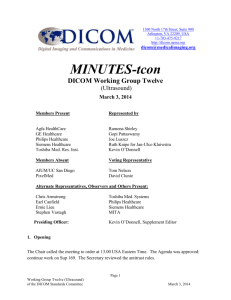

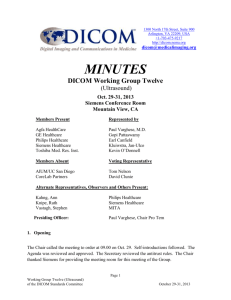
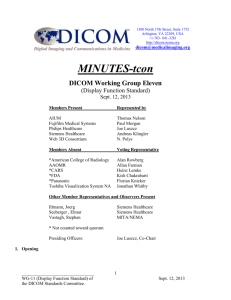
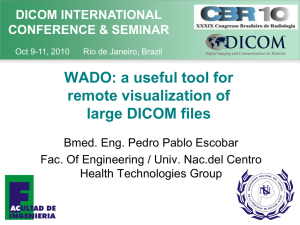


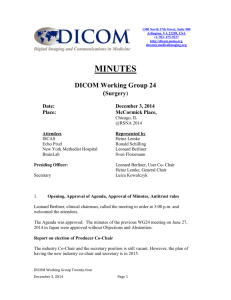
![Jiye Jin-2014[1].3.17](http://s2.studylib.net/store/data/005485437_1-38483f116d2f44a767f9ba4fa894c894-300x300.png)
